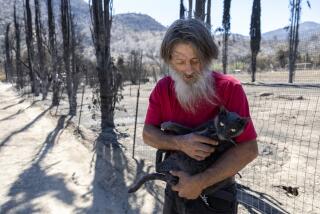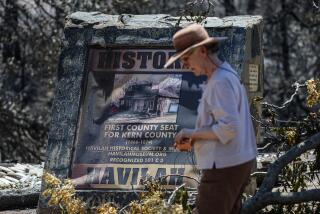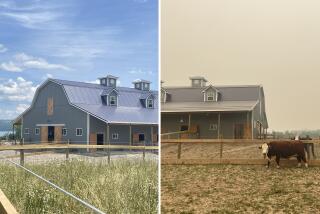Fires Turn Quiet Life of Amish to Ashes
BELLEVILLE, Pa. — In two hours, an arsonist destroyed six barns, damaged a seventh barn and a schoolhouse, killed 172 animals--and shattered an Amish community’s way of life, perhaps forever.
Within four weeks of the March 15 fires, Belleville’s Amish had rebuilt the barns, thanks in part to $600,000 in donations from Amish and non-Amish nationwide. Area schoolchildren collected money to buy draft horses and other livestock for their neighbors.
But no amount of charity can restore the community’s privacy. The arsonist’s flames brought the world to a people who had managed to live in isolation since their ancestors settled here in 1791.
“It called attention to their presence. Many more people will know about them, their location, their life,” said John Hostetler, born an Amish here and now a professor emeritus of anthropology at Temple University.
“This is now another spot in Pennsylvania where the Amish are known to live. . . . It will probably be more publicized for people to come into the area,” Hostetler said.
And where the Amish have been publicized before, tourism and development have followed.
“We don’t want wall-to-wall tourists like Lancaster County,” said Gene Glick, who runs the Belleville Livestock Auction each Wednesday. “This is a fresh breeze compared to that.”
In Lancaster County, Amish caricatures scream from billboards, enticing visitors to amusement parks, museums and Pennsylvania Dutch tourist traps. Around Belleville, in central Pennsylvania’s Mifflin County, a single horse-and-buggy sign on U.S. 322 gives the only hint that Amish are nearby.
A few of the local Amish trade with the “English,” selling quilts or furniture to the occasional visitor. As a sect, they are content to live their lives separate from the rest of the world.
But this community’s ability to live apart disappeared during the as-yet-unsolved arson spree on March 15. Damage was estimated at $1 million, as everything from seed to plows went up in smoke.
Cash donations and shipments of livestock poured in as word of the disaster spread. Finally, spectators arrived to watch barns rebuilt in a day.
“They understand and appreciate the people who come to help them,” Hostetler said. “A certain amount of spectators can be expected and they understand that when they’re barn-raising.”
Some visitors have stepped past the line, even for the even-tempered Amish.
The Amish are reluctant to have their photos taken, citing the Bible’s prohibition against graven images. By barn raising No. 4 in early April, they had had enough.
Photographers cavorted inside uncompleted barns, endangering themselves and others. Tourists would drive up, get out and walk around farms without asking permission.
Finally, signs went up asking people to stay out of seeded fields and the barn-raising area.
Amish immigrants settled in Berks County, Pa., about 1737, Hostetler said, and spread to other areas of the state in the 1790s. Those who moved to Lancaster and Chester counties have had to deal with the increased development between Harrisburg and Philadelphia.
“What happens in the long run is that people discover these places and say, ‘Let’s move here.’ That’s a change of tremendous magnitude,” Hostetler said. “Around Lancaster, it changed from tourists coming in and staying a day to people coming in and staying.”
More to Read
Sign up for Essential California
The most important California stories and recommendations in your inbox every morning.
You may occasionally receive promotional content from the Los Angeles Times.









